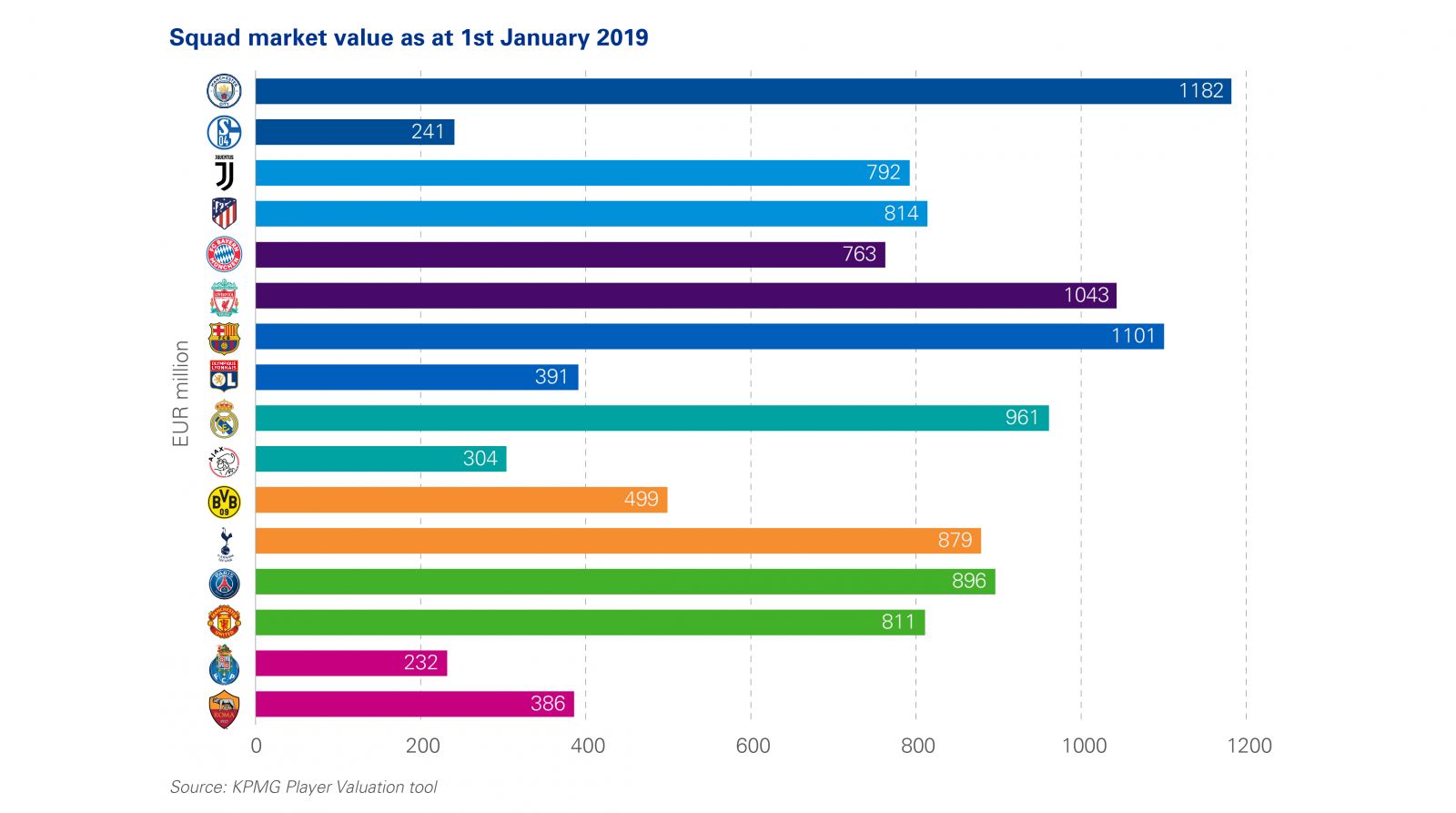14 out of the 16 teams relaunching their Champions League last-16 bid are from the so-called big five football leagues. The only exceptions are FC Porto and AFC Ajax, while the Premier League is represented by four teams, three clubs come from LaLiga, further three teams from Bundesliga, while Serie A and Ligue 1 are both represented by two clubs. The teams that progressed from the group stages also had the squads with the highest market value in their respective groups. Once again, the line-up in the final 16 underlines the correlation between financial power and on-pitch results. Ahead of the next clashes in the first legs of the round of 16, the KPMG Football Benchmark team have analysed this year’s UCL contenders from a business perspective.
In top football, it is common knowledge that those who spend more, have a better chance to come out on top. Considering the clubs that went through the group stages of this season’s Champions League, the correlation between squad value and sporting performance is quite spectacular. Indeed, looking at the results of the group stage, in all but one group the two teams with the highest squad value qualified for the knockout stages. The only exception was Group E, where Ajax managed to overtake Benfica, despite having a slightly less valuable squad.
The chart below shows how the group stages concluded with squads’ value as of September 2018
.png)
Round of 16 fixtures – comparing squad values
Nevertheless, we see big differences in financial might among the 16 teams – there are three clubs, namely Manchester City, Barcelona and Liverpool, whose squad value is over EUR 1 billion, while two clubs, Schalke 04 and Porto compete with squads of a total value of less than EUR 250 million, each.
The gaps in financial power are remarkable when we consider the actual ties in the round of 16, too. Among the 16 contenders, Manchester City can boast the most valuable squad with an overall value of over EUR 1,18 billion, while their current opponent, Schalke 04 have the least valuable team (EUR 241 million) only after Porto. Another unbalanced match in this context is Barcelona vs Olympique Lyonnais, considering that the Blaugrana have the second most valuable squad in the world, while the French team is third from the bottom in this special ranking. Furthermore, the value of Real Madrid’s squad is over EUR 650 million more than that of their current opponent, Ajax.
In this regard, the most balanced tie is the one between Juventus and Atlético Madrid, with a difference of only EUR 22 million between the two squads, in favour of the Spanish giant.
The next chart shows the round of 16 opponents with their squad values as of January 2019.

Operating revenues also underline the pattern
In terms of total operating revenues, Real Madrid, Barcelona and Manchester United are definitely the leaders, followed by Bayern Munich*, Manchester City and Paris Saint-Germain. In the current fixtures, the most evident gap in this respect is between Real Madrid and Ajax, considering that the Blancos boast revenues over eight times higher than the Dutch club.
The Galácticos are also the leaders in terms of commercial revenues, reaching EUR 326 million. Actually, this revenue source is the key form of income for almost all the 16 teams. In this respect, Paris Saint-Germain show the highest dependence on commercial revenues at 58%, followed by the German giants Bayern Munich FC at 53%.

*Note: All data refer to the individual financial statements of FC Bayern München AG. Consolidated data were not available at the date of publication.
On the other hand, there are also clubs that show a strong “teledependance”, such as Porto and Roma, with respectively 52% and 51% of revenues coming from TV rights. Such a high dependence on broadcasting revenues seems to confirm how fundamental participating in the UEFA Champions League can be for smaller teams.
The bigger, the more popular
This connection between football and entertainment is even stronger if we consider social media, which have become a crucial part of the way footballers connect with their fans around the world.
Football clubs are becoming even more like entertainment companies, capable of attracting not only fans, but also customers from all over the world, by turning into global brands.

Spanish giants Real Madrid and Barcelona are undoubtedly the leaders in social media as they established their supremacy both on and off-the pitch. Indeed, both can boast more than 200 million followers on their official Facebook, Twitter, Instagram and YouTube profiles. Interestingly, they now face two of the least popular clubs on social networks among the 16 contenders, namely Ajax and Olympique Lyonnaise, both with just 5 million followers.
Certainly, football players have taken the starring role on social media platforms, often outperforming their clubs regarding the number of followers. This is clearly the case for Cristiano Ronaldo, who as we mentioned also in our Ronaldo Economics report, provided Juventus not only with sporting benefits, but also with millions of social media followers combined.
In addition, the correlation between financial and sporting performance is supported by the fact that this year’s top 16 contenders have generated 13% more turnover than the top 16 teams last year (EUR 6.6 billion in this edition vs EUR 5.9 billion in the previous one). It appears inevitable that the bigger clubs will keep benefiting more than others – for instance, some of the most valuable clubs, namely Barcelona, Real Madrid, Bayern Munich, Paris Saint-Germain, Manchester City and Juventus have always qualified to the Round of 16 of the Champions League in all of the last five editions of the tournament. Furthermore, if we take into consideration that only 32 teams took part in the knockout phases of the tournament in past 5 years, the evidence that the richer clubs are more successful seems stronger than ever, and the trend is set to continue.


